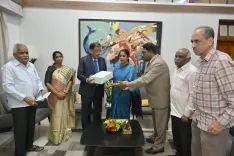How is the Maharashtra Government Implementing the ‘Manhole to Machinehole’ Scheme?

Synopsis
Key Takeaways
- The ‘Manhole to Machinehole’ scheme aims to eliminate manual scavenging through mechanization.
- Rs 504 crore has been allocated for the implementation of the program.
- Training and maintenance for sanitation workers and equipment are prioritized.
- The initiative reflects a commitment to improving public health and worker dignity.
- Housing support for sanitation workers' families is also being enhanced.
Mumbai, July 30 (NationPress) Deputy Chief Minister Ajit Pawar urged the administration to ensure the effective execution of the ‘Manhole to Machinehole’ scheme, aiming to eliminate the practice of manual scavenging. Under this initiative, drains, sewer systems, and septic tanks will be cleared using mechanized tools. The plan encompasses the acquisition of cleaning machinery, modern vehicles, and emergency response sanitation units.
Ajit Pawar, who presided over the meeting addressing issues related to sanitation workers, noted that the urban development department is carrying out the scheme, supported by an approved budget of Rs 504 crore.
An additional Rs 100 crore was approved during the Monsoon Session of 2024–25 and allocated to the department by March 31, 2025.
The procurement of robotic devices, cleaning machinery, and emergency vehicles has commenced. He mandated that the maintenance of these vehicles for three years and the training of sanitation workers for their operation be guaranteed by the respective agency.
This meeting occurred shortly after Ajit Pawar informed the state assembly during the monsoon session that the government would implement a time-bound strategy to fully eradicate manual scavenging and replace the cleaning of drains and sewer lines across Maharashtra with machinery.
He also assured the assembly that the government would allocate the necessary funds.
“Under the Dr Babasaheb Ambedkar Shram Safalya Awas Yojana, free housing units are granted to the eligible heirs of conservancy workers after their retirement or in the event of their death while in service. Currently, this benefit is available only to sanitation workers who have served for 25 years or more,” stated Ajit Pawar.
He instructed the Urban Development Department to devise a proposal to reduce this service requirement from 25 years to 20 years and submit it to the Cabinet.
“The state government resolution based on the recommendations of the Lad-Page Committee must be enacted by all municipal corporations and councils promptly. Non-compliance will result in severe consequences,” he cautioned.
He further directed that every municipal corporation and council must provide a comprehensive report to the Urban Development Department regarding the number of sanitation workers currently employed within their jurisdiction.





